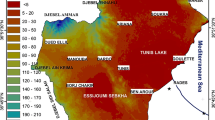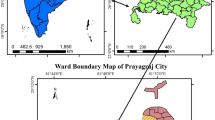Abstract
As an extension of type-1 fuzzy sets (T1FSs), interval type-2 fuzzy sets (IT2FSs) can be used to model both extrinsic and intrinsic uncertainties. Based on the likelihood of interval type-2 fuzzy numbers (IT2FNs), this paper proposes a new multi-attributive border approximation area comparison (MABAC) approach to solve multi-criteria decision-making (MCDM) problems. First, an algorithm to decompose IT2FNs into the embedded type-1 fuzzy numbers (T1FNs) is proposed. Second, based on the closeness degree of T1FNs, the likelihood of IT2FNs is defined using the decomposition algorithm, and related properties are discussed. Third, the total ranking of alternatives is obtained using the MABAC approach based on the likelihood of IT2FNs. Finally, a practical example of selecting hotels from a tourism website is presented to verify the validity and feasibility of the proposed approach. A comparative analysis with existing methods is also described.




Similar content being viewed by others
References
Wallsten, T.S., Budescu, D.V.: A review of human linguistic probability processing: general principles and empirical evidence. Knowl. Eng. Rev. 10(1), 43–62 (1995)
Zadeh, L.A.: Fuzzy sets. Inf. Control 8(3), 338–353 (1965)
Yager, R.R.: Multiple objective decision-making using fuzzy sets. Int. J. Man Mach. Stud. 9(4), 375–382 (1977)
Nan, J.X., Wang, T., An, J.J.: Intuitionistic fuzzy distance based TOPSIS method and application to MADM. Int. J. Fuzzy Syst. Appl. 5(1), 43–56 (2016)
Xia, M.M., Xu, Z.S., Liao, H.C.: Preference relations based on intuitionistic multiplicative information. IEEE Trans. Fuzzy Syst. 21(1), 113–133 (2013)
Atanassov, K.T.: Intuitionistic fuzzy sets. Fuzzy Sets Syst. 20(1), 87–96 (1986)
Yang, J., Wei, F., Li, D.F.: Non-linear programming approach to solve bi-matrix games with payoffs represented by I-fuzzy numbers. Int. J. Fuzzy Syst. 18(3), 492–503 (2016)
Wang, J.Q., Han, Z.Q., Zhang, H.Y.: Multi-criteria group decision-making method based on intuitionistic interval fuzzy information. Group Decis. Negot. 23, 715–733 (2014)
Wang, C.H., Wang, J.Q.: A multi-criteria decision-making method based on triangular intuitionistic fuzzy preference information. Intell. Autom. Soft Comput. 22(3), 473–482 (2016)
Yu, D.J., Liao, H.C.: Visualization and quantitative research on intuitionistic fuzzy studies. J. Intell. Fuzzy Syst. 30, 3653–3663 (2016)
Atanassov, K., Gargov, G.: Interval valued intuitionistic fuzzy sets. Fuzzy Sets Syst. 31(3), 343–349 (1989)
Liao, H.C., Xu, Z.S., Xia, M.M.: Multiplicative consistency of interval-valued intuitionistic fuzzy preference relation. J. Intell. Fuzzy Syst. 27(6), 2969–2985 (2014)
Zhou, H., Wang, J., Li, X.E., Wang, J.Q.: Intuitionistic hesitant linguistic sets and their application in multi-criteria decision-making problems. Oper. Res. Int. J. 16(1), 131–160 (2016)
Liao, H.C., Xu, Z.S., Zeng, X.J.: Novel correlation coefficients between hesitant fuzzy sets and their application in decision making. Knowl.-Based Syst. 82, 115–127 (2015)
Peng, J.J., Wang, J.Q., Wu, X.H.: Novel multi-criteria decision-making approaches based on hesitant fuzzy sets and prospect theory. Int. J. Inf. Technol. Decis. 15(3), 621–643 (2016)
Zhou, H., Wang, J.Q., Zhang, H.Y.: Multi-criteria decision-making approaches based on distance measures for linguistic hesitant fuzzy sets. J. Oper. Res. Soc. (2016). doi:10.1057/jors.2016.41
Wu, X.H., Wang, J.Q., Peng, J.J., Chen, X.H.: Cross-entropy and prioritized aggregation operator with simplified neutrosophic sets and their application in multi-criteria decision-making problems. Int. J. Fuzzy Syst. (2016). doi:10.1007/s40815-016-0180-2
Tian, Z.P., Wang, J., Wang, J.Q., Zhang, H.Y.: Simplified neutrosophic linguistic multi-criteria group decision-making approach to green product development. Group Decis. Negot. (2016). doi:10.1007/s10726-016-9479-5
Zadeh, L.A.: The concept of a linguistic variable and its application to approximate reasoning—I. Inf. Sci. 8(3), 199–249 (1975)
Mendel, J.M.: Type-2 fuzzy sets: some questions and answers. IEEE Connect. 1, 10–13 (2003)
Mendel, J.M., John, R.I., Liu, F.: Interval type-2 fuzzy logic systems made simple. IEEE Trans. Fuzzy Syst. 14(6), 808–821 (2006)
Mendel, J.M.: On answering the question “where do I start in order to solve a new problem involving interval type-2 fuzzy sets?”. Inf. Sci. 179(19), 3418–3431 (2009)
Wu, D., Mendel, J.M.: A comparative study of ranking methods, similarity measures and uncertainty measures for interval type-2 fuzzy sets. Inf. Sci. 179(8), 1169–1192 (2009)
Chen, S.M., Lee, L.W.: Fuzzy multiple attributes group decision-making based on the ranking values and the arithmetic operations of interval type-2 fuzzy sets. Exp. Syst. Appl. 37(1), 824–833 (2010)
Gong, Y.B.: Fuzzy multi-attribute group decision making method based on interval type-2 fuzzy sets and applications to global supplier selection. Int. J. Fuzzy Syst. 15(4), 392–400 (2013)
Yager, R.R.: Containment and specificity for type-2 fuzzy sets. Int. J. Fuzzy Syst. 9(2), 55–66 (2007)
Han, Z.Q., Wang, J.Q., Zhang, H.Y., Luo, X.X.: Group multi-criteria decision making method with triangular type-2 fuzzy numbers. Int. J. Fuzzy Syst. (2015). doi:10.1007/s40815-015-0110-8
Hu, J.H., Xiao, K.L., Chen, X.H., Liu, Y.M.: Interval type-2 hesitant fuzzy set and its application in multi-criteria decision making. Comput. Ind. Eng. 87, 97–103 (2015)
Chen, S.M., Lee, L.W.: Fuzzy multiple attributes group decision-making based on the interval type-2 TOPSIS method. Exp. Syst. Appl. 37(4), 2790–2798 (2010)
Baležentis, T., Zeng, S.: Group multi-criteria decision making based upon interval-valued fuzzy numbers: an extension of the MULTIMOORA method. Exp. Syst. Appl. 40(2), 543–550 (2013)
Wang, J.Q., Yu, S.M., Wang, J., Chen, Q.H., Zhang, H.Y., Chen, X.H.: An Interval type-2 fuzzy number based approach for Multi-criteria group decision-making problems. Int. J. Uncertain. Fuzziness Knowl.-Based Syst. 23(4), 565–588 (2015)
Wang, J., Chen, Q.H., Zhang, H.Y., Chen, X.H., Wang, J.Q.: Multi-criteria decision-making method based on type-2 fuzzy sets. FILOMAT (2015)
Chen, T.Y.: An ELECTRE-based outranking method for multiple criteria group decision making using interval type-2 fuzzy sets. Inf. Sci. 263, 1–21 (2014)
Chen, T.Y.: A PROMETHEE-based outranking method for multiple criteria decision analysis with interval type-2 fuzzy sets. Soft. Comput. 18(5), 923–940 (2014)
Pamučar, D., Ćirović, G.: The selection of transport and handling resources in logistics centers using multi-attributive border approximation area comparison (MABAC). Exp. Syst. Appl. 42(6), 3016–3028 (2015)
Xue, Y.X., You, J.X., Lai, X.D., Liu, H.C.: An interval-valued intuitionistic fuzzy MABAC approach for material selection with incomplete weight information. Appl. Soft Comput. 38, 703–713 (2016)
Peng, X.D., Yang, Y.: Pythagorean fuzzy choquet integral based MABAC method for multiple attribute group decision making. Int. J. Intell. Syst. (2016). doi:10.1002/int.21814
Chen, T.Y.: An interval type-2 fuzzy PROMETHEE method using a likelihood-based outranking comparison approach. Inf. Fusion 25, 105–120 (2015)
Tian, Z.P., Wang, J., Wang, J.Q., Zhang, H.Y.: A likelihood-based qualitative flexible approach with hesitant fuzzy linguistic information. Cognitive Comput. (2016). doi:10.1007/s12559-016-9400-1
Chen, T.Y.: An interval type-2 fuzzy technique for order preference by similarity to ideal solutions using a likelihood-based comparison approach for multiple criteria decision analysis. Comput. Ind. Eng. 85, 57–72 (2015)
Wan, S.P., Dong, J.Y.: Possibility linear programming with trapezoidal fuzzy numbers. Appl. Math. Model. 38(5), 1660–1672 (2014)
Grzegorzewski, P., Mrówka, E.: Trapezoidal approximations of fuzzy numbers. Fuzzy Sets Syst. 153(1), 115–135 (2005)
Hatami-Marbini, A., Tavana, M.: An extension of the ELECTRE I method for group decision-making under a fuzzy environment. Omega 39(4), 373–386 (2011)
Chen, T., Lin, C.T., Huang, S.F.: A fuzzy approach for supplier evaluation and selection in supply chain management. Int. J. Prod. Econ. 102(2), 289–301 (2006)
Kahneman, D., Tversky, A.: Prospect theory: an analysis of decision under risk. Econ.: J. Econ. Soc. 263–291 (1979)
Acknowledgments
The authors thank the editors and anonymous reviewers for their helpful comments and suggestions. This work was supported by the National Natural Science Foundation of China (Nos. 71271218, 71571193, and 71431006).
Author information
Authors and Affiliations
Corresponding author
Ethics declarations
Conflict of Interest
The authors declare that there are no conflicts of interest regarding the publication of this paper.
Appendix
Appendix
\(\tilde{A} = \left[ {\left( {0.6,0.7,0.7,0.8;0.9} \right),\left( {0.5,0.7,0.7,0.9;1} \right)} \right]\), let n = 100; then the embedded T1TrFNs can be identified as shown in Table 7.
Rights and permissions
About this article
Cite this article
Yu, Sm., Wang, J. & Wang, Jq. An Interval Type-2 Fuzzy Likelihood-Based MABAC Approach and Its Application in Selecting Hotels on a Tourism Website. Int. J. Fuzzy Syst. 19, 47–61 (2017). https://doi.org/10.1007/s40815-016-0217-6
Received:
Revised:
Accepted:
Published:
Issue Date:
DOI: https://doi.org/10.1007/s40815-016-0217-6




